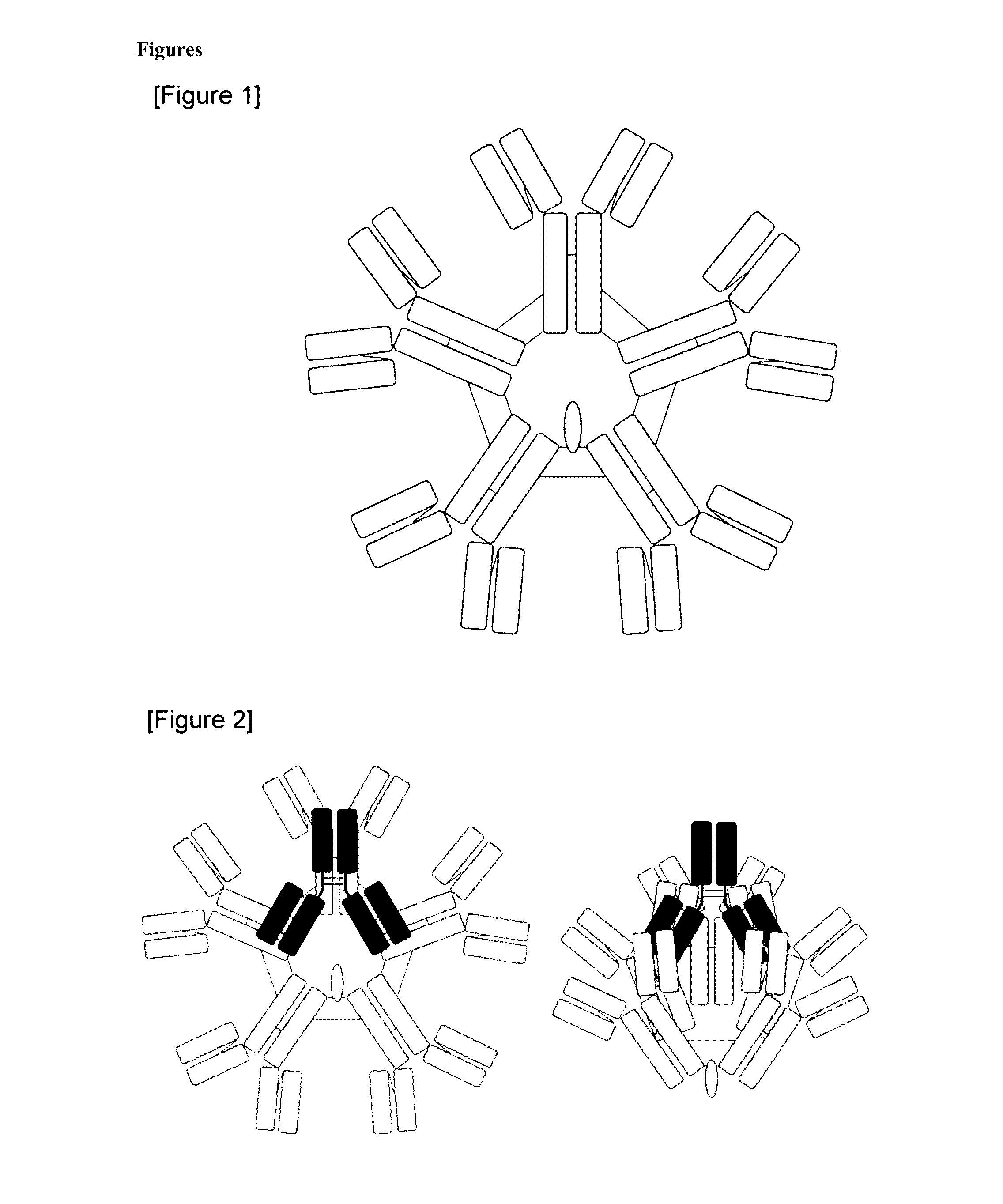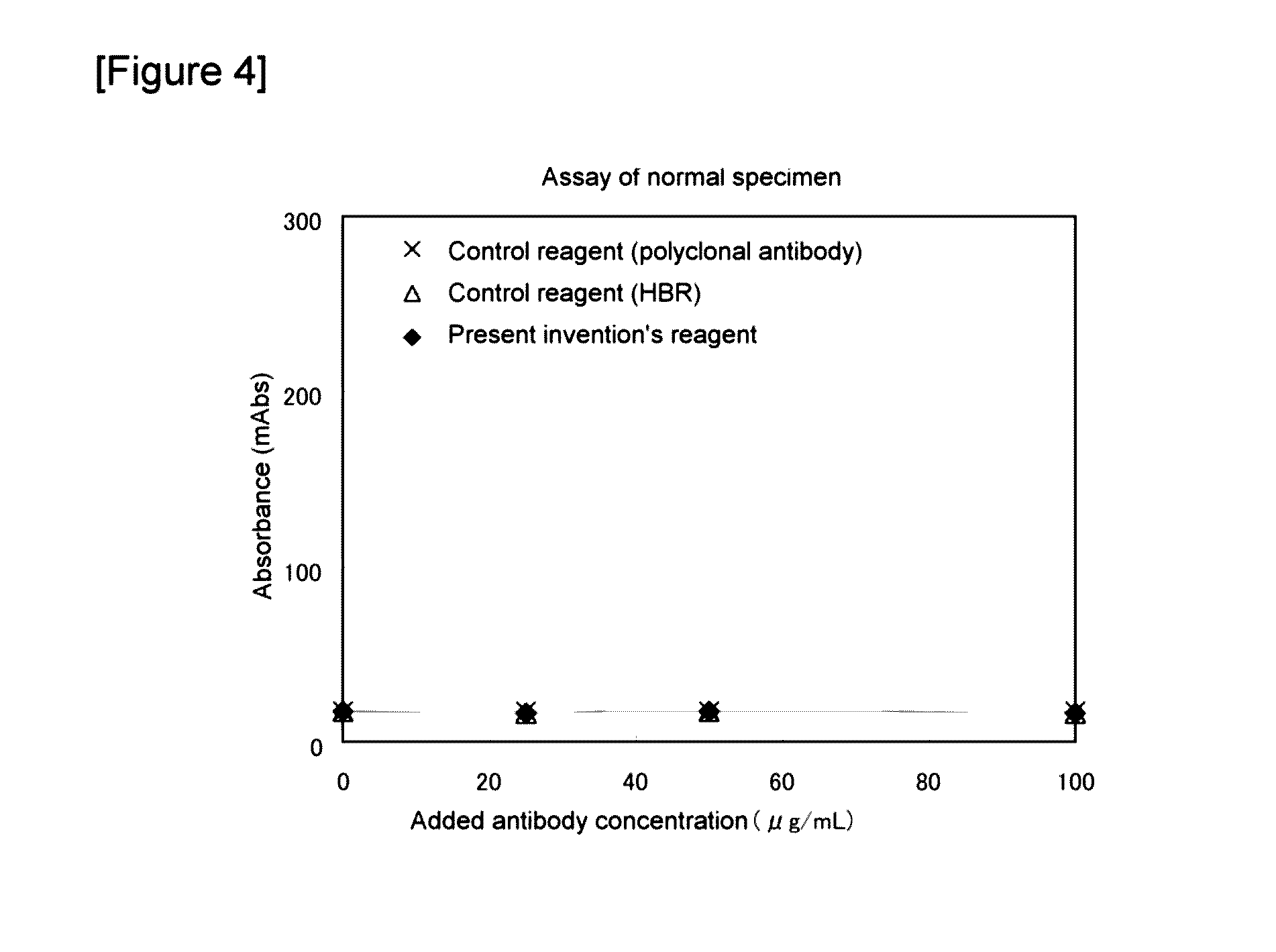Anti-human igm monoclonal antibody and immunoassay using the same
a monoclonal antibody and antibody technology, applied in the field of antihuman igm monoclonal antibody and immunoassay using the same, can solve the problems of inability to efficiently induce agglutination of igm monoclonal antibody, low specificity of polyclonal antibody that binds to multiple epitopes, etc., to achieve high precision, neutralize igm interference efficiently, and high quality and inexpensive
- Summary
- Abstract
- Description
- Claims
- Application Information
AI Technical Summary
Benefits of technology
Problems solved by technology
Method used
Image
Examples
example 1
Verification of Immunoagglutination by the Anti-Human IgM Monoclonal Antibody and its Potential Utility as an Agent for Suppressing Non-Specific Reactions
(1) Preparation of Human IgM Solutions
[0103]A solution containing human IgM (manufactured by the CHEMICON corporation) at 200 μg / mL was serially diluted in PBS to prepare 100, 50, and 25 μg / mL human IgM solutions.
(2) Preparation of a Solution of the Anti-Human IgM Monoclonal Antibody t
[0104]100 mM Tris-hydrochloric acid buffer solution (pH 8.0) containing 3% polyethylene glycol 6000, 5 mM trisodium citrate and 2.5 mM calcium chloride (anhydride) (hereafter referred to as the antibody diluting solution) was used to dilute the anti-human immunoglobulin M monoclonal antibody t of the present invention to a final concentration of 400 μg / mL, to prepare a solution of the anti-human IgM monoclonal antibody t. As a control, a solution of the heterophilic blocking reagent HBR was prepared by diluting the heterophilic blocking reagent HBR (m...
example 2
Verification of an Effect of Suppressing Non-Specific Reactions [1] (with the Latex Reagent for PSA Testing)
[0108]The present invention's effect on the non-specific reactions seen with the latex reagent for PSA testing, which uses an anti-PSA monoclonal antibody, was verified by measuring the reaction strength in a general automatic analyzer device. PSA is a glycoprotein that has a molecular weight of about 34,000 and is produced specifically in the epithelial cells of the prostate gland, and it is used in the screening (medical examination) for prostate cancer, one of the typical malignant tumors in men of advanced ages.
(1) Reagents
(1-1) First Reagent
(i) Basic Reagent
[0109]30 mM HEPES buffer solution (pH 7.0) containing 0.5 M KCl and 0.1% BSA (bovine serum albumin)
(ii) The Reagent of the Present Invention
[0110]The solution of the anti-human IgM monoclonal antibody t that is capable of inducing immunoagglutination based on an antigen-antibody reaction with human immunoglobulin M by ...
example 3
Verification of an Effect of Suppressing Non-Specific Reactions [2] (with the Latex Reagent for CRP Testing)
[0119]The present invention's effect on the non-specific reactions seen with the latex reagent for CRP testing, which uses an anti-CRP monoclonal antibody, was verified by making measurements in a general automatic analyzer device. CRP is well known as a non-specific inflammation marker.
(1) Reagent
(1-1) First Reagent
(i) Basic Reagent
[0120]20 mM Tris-hydrochloric acid buffer solution (pH 8.5) containing 500 mM sodium chloride.
(ii) The Reagent of the Present Invention
[0121]The solution of the anti-human IgM monoclonal antibody t that is capable of inducing immunoagglutination based on an antigen-antibody reaction with human IgM by itself was added to the basic reagent to make the final concentration of the antibody to be 50 μg / mL.
(iii) Control Reagent
The normal mouse IgG that has a suppression effect on the passive non-specific reactions or the commercially available heterophili...
PUM
| Property | Measurement | Unit |
|---|---|---|
| concentration | aaaaa | aaaaa |
| concentration | aaaaa | aaaaa |
| particle size | aaaaa | aaaaa |
Abstract
Description
Claims
Application Information
 Login to View More
Login to View More - R&D
- Intellectual Property
- Life Sciences
- Materials
- Tech Scout
- Unparalleled Data Quality
- Higher Quality Content
- 60% Fewer Hallucinations
Browse by: Latest US Patents, China's latest patents, Technical Efficacy Thesaurus, Application Domain, Technology Topic, Popular Technical Reports.
© 2025 PatSnap. All rights reserved.Legal|Privacy policy|Modern Slavery Act Transparency Statement|Sitemap|About US| Contact US: help@patsnap.com



